Prioritizing tasks is one of the important steps you should get practice in order to manage your task and your time. As BeforeSunset, we try our best to help you with time management, and we believe that time management comes also with prioritizing. Therefore, Ivy Lee Method is one of the not so time-consuming ways you can use to become more productive.
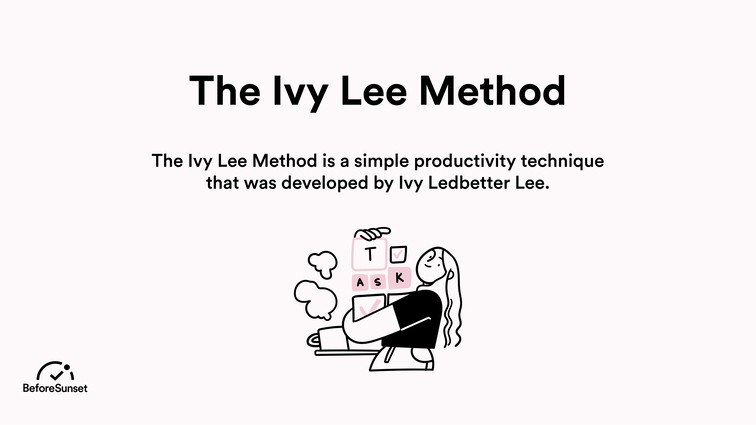
The History of the Ivy Lee Method
Did you know that Ivy Lee Method was around for 100 years?
The origin of this method comes from Ivy Lee, a management consultant, who created the Ivy Lee Method in the early 20th century. According to the story, Lee worked for some of his era's most prosperous businesses, including Charles Schwab and the Pennsylvania Railroad.
The president of Bethlehem Steel Corporation, Charles M. Schwab, is said to have been pleased by Lee's work and approached him for advice on how to boost employee productivity. According to reports, Lee advised Charles Schwab that he might boost productivity by having his staff prioritize their duties and concentrate on the most crucial ones first.
After asking Schwab's staff to list their top priorities for the following day in order of importance, Lee allegedly demonstrated the technique by having them concentrate on finishing the first assignment before moving on to the next task.
According to reports, after using the technique, Schwab noticed a rise in productivity and was so satisfied that he paid Lee $25,000 for the advice—roughly $700,000 in today's dollars.
Other businesses then adopted the approach, and it is still frequently used today as a straightforward and efficient technique to boost production and concentrate on the most crucial activities.
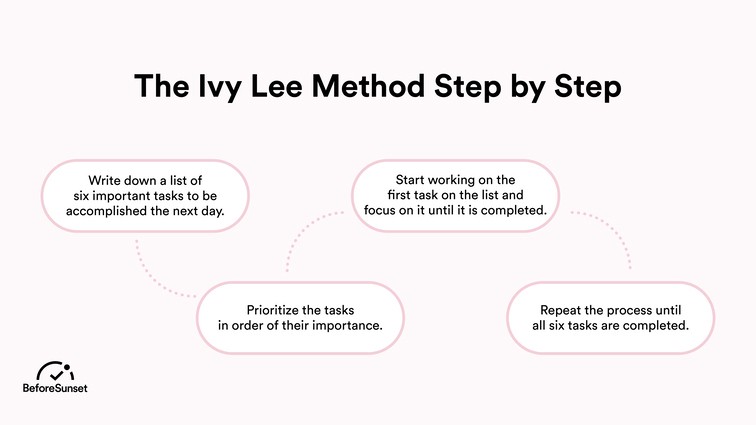
Step-by-Step Guide
Step 1: Create A List
At the end of each day, create a list of the most important six tasks to accomplish the next day. It should not be more than six since this method helps you execute important tasks.
At the end of the day is not a must, but you should find a suitable time of your day to create the list because making the list is the most crucial step of the Ivy Lee Method. Evening or the morning is advised to be more ideal periods of time.
Step 2: Make an Order of Your Tasks
You should list them according to their importance. The order of your tasks should start from most important to least important.
The first task or the “Task 1” should be the most important one, and the last or sixth task should be the least important.
If you choose to do the list the night before, don't forget to get a rest since it's an essential part of productivity and focus.
Step 3: Begin Working on The Tasks
According to your list, start your day and begin working on your tasks. We know it is kind of hard but try your best to work until you are finished while trying to reduce the distractions.
Do not start doing another task without being finished with the task you are working on. This is a must because consistency is crucial for this method. If you manage to focus and work on one task at a time, you will be able to manage your time and do multiple tasks together in a good way, moreover, you will be able to train yourself into becoming more disciplined.
Step 4: Don't Forget to Cross Out the Finished Tasks
Doing this gives you a feeling of relief and happiness which will encourage you to do more!
Step 5: Postpone Unfinished Task to The Next Day
You don't have to worry about unfinished tasks. It's okay if you cannot accomplish every one of those six tasks on your list. You might be tired that day, have problems focusing, and have lots of distractions.
If you experience this, you can just simply move the uncompleted task/s to the next day.
Step 6: Repeat
Repeat this method every day and at the end of the week see how many tasks you accomplish compared to before. As you practice Ivy Lee Method, you can be able to monitor yourself, modify your list however you want, and see whether you boost your productivity.
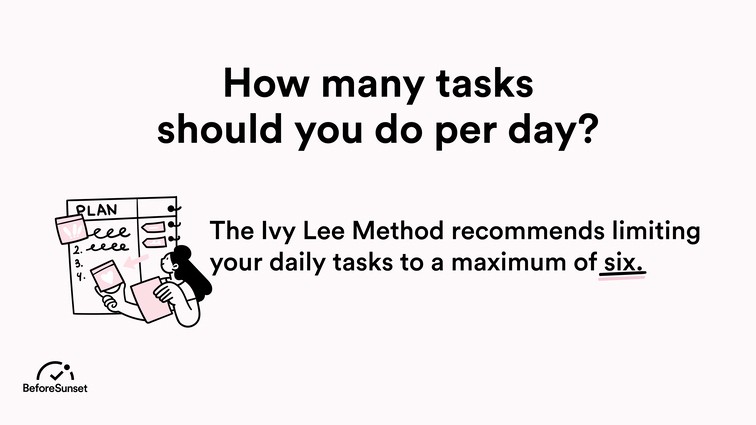
How Many Tasks Per Day?
You may increase your attention and productivity by using the Ivy Lee approach, which is a straightforward productivity tool. The technique entails selecting your six most essential activities for the day, deciding which ones should come first, and concentrating on one at a time until it is finished before moving on to the next.
The appropriate amount of tasks you should try to do each day may vary based on your unique objectives, priorities, and workload, even though the system is adaptable and can be tailored to match any schedule or work style. Depending on their workload or other conditions, some people find that six tasks are sufficient to keep them productive and engaged throughout the day, while others may need to change the number of activities. Just remember that the first task is the most important task.
The Ivy Lee method's last success factor is prioritizing your chores according to their priority and concentrating on finishing each one without becoming sidetracked by other work or distractions. You may maintain focus, lessen procrastination, and move steadily closer to your objectives by doing this.
What is a Daily To Do List?
A daily to-do list is a list of tasks or activities that you plan to accomplish in a single day. It's a tool for organizing your tasks and keeping track of your progress toward your goals. A daily to-do list typically includes a variety of tasks, such as work-related tasks, household chores, personal errands, and self-care activities.
A daily to-do list can help you stay focused and productive by providing a clear plan for your day. By writing down your tasks and prioritizing them, you can ensure that you make progress on your most important goals and avoid getting distracted by less important tasks or interruptions.
To create a daily to-do list, start by identifying the tasks you need to accomplish for the day. Then, prioritize your tasks based on their importance and urgency. You might choose to organize your list by category, such as work tasks, personal tasks, or self-care activities. Once you've created your list, work through it systematically, focusing on one task at a time until it's completed before moving on to the next one.
Remember, a daily to-do list is a flexible tool that can be adapted to fit your needs and preferences. It's important to find a system that works for you and stick with it to ensure that you stay organized, productive, and on track toward your goals.

How Do I Get My To-Do List Done?
You may use the following tactics to cross things off your to-do list:
Set priorities for your work: Begin by deciding which of your chores are the most crucial and urgent, and concentrate on doing them first. This can assist you in moving forward with your most essential objectives while lowering your chance of becoming sidetracked by unimportant chores.
Large jobs may be broken down into smaller, more manageable pieces. If you have a large item on your to-do list, consider doing so. This might encourage you to keep going and move the work closer to completion.
Establish attainable targets: About what you can complete in a day, be realistic. Don't overstuff your to-do list otherwise you risk feeling overwhelmed and accomplishing little.
Set a timer for a certain period of time, then focus on a job for that duration. You can stay on task and keep out of trouble by doing this.
Avoid or reduce interruptions by putting your phone on silent, shutting your email, or working in a quiet area. You may be able to remain attentive and effective as a result.
To refuel your energy and keep your attention throughout the day, take pauses. For mental relaxation and stress reduction, you can try going for a little stroll or doing some rapid meditation.
Evaluate and make changes to your to-do list: At the end of the day, evaluate your results and make changes for the next day. This can guarantee that you continue to move forward and that you stay on track with your objectives.
Keep in mind that being focused, giving your chores priority, and having a realistic idea of how much you can get done in a day are the keys to clearing your to-do list. You may boost your productivity and more successfully accomplish your goals by using these tactics.
How Many Items Should Be on a To Do List?
The number of things on a to-do list might vary from person to person and from job to job. Some people might think a lengthier to-do list is reasonable, while others would prefer a shorter one because they find it too daunting.
You should prioritize keeping your to-do list short and simple. The rule of thumb is to check no more than six tasks off your daily to-do list. Maintaining concentration in this way helps you get the most important work done first.
But, this is not an inflexible rule, and you may find that a different combination of pursuits best suits you. Keep in mind that everything on your to-do list is doable and you can keep moving forward without feeling overwhelmed.
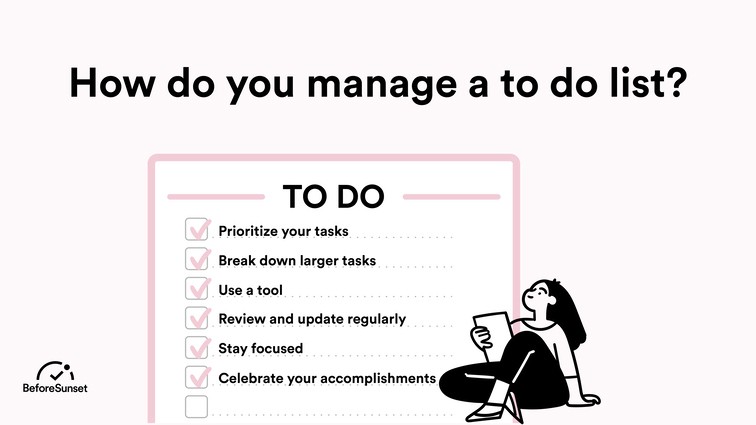
How Do You Manage a To Do List?
To manage a to-do list effectively, start by identifying your most important tasks and prioritizing them based on their urgency and importance. Use a system of categorization or numbering to organize your list and ensure that you stay focused on the most critical tasks. Break down larger tasks into smaller, more manageable steps to make progress more quickly and avoid feeling overwhelmed.
Regularly review your to-do list throughout the day to track your progress and adjust your priorities as needed. Consider using a timer or productivity app to help you stay on track and avoid distractions.
Finally, be flexible and willing to adjust your to-do list based on unexpected events or changes in priorities. Remember that a to-do list is a tool to help you manage your tasks and goals, and it should be adapted to fit your needs and preferences. By following these tips, you can effectively manage your to-do list and achieve your goals more efficiently.
What Tasks Should You Do Everyday?
Every person has a unique set of objectives, commitments, and aspirations that influence their everyday tasks. Yet, people find the following common everyday activities helpful:
Before you start, take a moment to make a list of the most important tasks you need to do.
Regular physical exercise is a must for a healthy lifestyle. Try to engage in 30 minutes or more of moderate activity each day, such as walking, yoga, or jogging.
Consuming a balanced diet is crucial for maintaining good health. By preparing your meals ahead of time, you can be sure to consume a balanced diet that includes fruits, vegetables, healthy grains, and lean meats.
Plan some time each day for yourself to engage in soothing and revitalizing self-care activities. Some instances of this include reading, taking a bath, and spending time in nature.
Continuing your education might help you pick up new skills and keep your mind active. Make time each day to read or learn something new.
Maintaining one's mental and emotional wellness requires social engagement. Even if it's only a quick text or phone call, spend some time chatting to your family, friends, or coworkers.
Keep in mind that the secret to a good daily routine is setting priorities for the tasks that are most essential to you and that will help you achieve your personal goals. Be your own productivity consultant.
Why Do I Feel Like I Never Get Anything Done?
It might be annoying and demotivating to feel like you never accomplish anything. Here are a few typical causes for your feelings:
Lack of clarity: You can experience overwhelm or be unclear of where to begin if you don't clearly comprehend what you must accomplish or what your goals are.
Multitasking: Attempting to perform too many tasks at once might be ineffective and result in a feeling that nothing gets accomplished. It might be difficult to focus on any one task while you're trying to juggle several, which can result in incomplete or subpar work.
Procrastination: Postponing tasks till the last minute might make one feel as though they accomplished nothing. This may be especially true if you regularly rush to finish chores in order to meet deadlines because doing so might make you feel worn out and exhausted.
Distractions: It can be challenging to concentrate and finish activities when there are constant interruptions, such as phone calls, emails, or social media updates.
Unreasonable expectations: From demanding perfection from ourselves to striving to do too much in too little time, we sometimes have unreasonable expectations for ourselves. When we fall short of these standards, it may feel like we are doing nothing.
It may be useful to determine which of these variables may be causing your perception of ineffectiveness if you feel like you never get anything done. From there, you may concentrate on creating tactics to get beyond these challenges, such establishing specific goals, refraining from multitasking, breaking down activities into smaller pieces, and minimizing distractions. If you feel like you're having trouble moving forward, it could be beneficial to ask a reliable friend, workmate, or expert for assistance.
What Time of Day Is Peak Productivity?
Depending on each person's unique circadian rhythms, as well as other variables like job schedules and lifestyle choices, the time of day when they are most productive might vary. However, studies have shown that the majority of people are most productive in the late morning to early afternoon.
This is due to the fact that at this period, our bodies naturally reach their highest levels of alertness and cognitive performance. Our cortisol levels, which are chemicals that support our ability to maintain mental clarity and concentrate, normally reach their highest point in the morning and then progressively decline during the day. In the morning, our body temperature tends to rise, which may make us feel more focused and alert.
However, some people can discover that certain times of the day are when they are most productive. If you're a night owl, for instance, you could discover that your most productive times are in the evening or at night, when your cortisol levels and body temperature are greater.
The optimal time of day for maximum productivity ultimately depends on your personal tastes and circumstances. To determine what works best for you, it might be useful to pay attention to your own natural cycles and try out various work patterns.
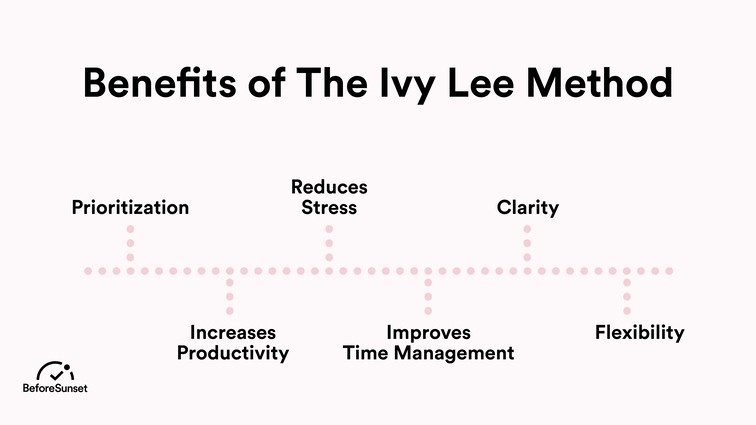
What Are The Benefits of The Ivy Lee Method?
Have you ever wondered what the Ivy Lee Method is and how it can benefit your productivity? If so, wonder no more. In this part, we will discuss the various ways in which this method can help you up your productivity.
1. Prioritization
The Ivy Lee Method assists you in terms of prioritizing your tasks. This way, you can ensure that you are focusing on accomplishing the most important and crucial task of the day as you go with the order of the tasks in your list.
2. Increases Productivity
You can get more done in less time by completing tasks in the order of their importance. In addition, this method can improve your focus and discipline in the long run.
3. Reduces Stress
The Ivy Lee Method enables you to have control over your task by concentrating on one task at a time and having a clear strategy which leads to reduce in your stress level.
4. Improves Time Management
You can review your progress at the end of each day and make adjustments to your list for the next day to manage your time better.
5. Clarity
Making a list of your 6 tasks provides a clear vision of the tasks you need to do while making it easier to prioritize and complete them throughout the day.
6. Flexibility
It is a simple method you can use different kinds of tasks that can be adapted to your schedule and specific needs.
Why Does the Ivy Lee Method Works?
The Ivy Lee approach for boosting productivity is still in use more than a century after it was first used. The technique is built on a few straightforward ideas that have been shown to increase production, attention, and efficiency.
The Ivy Lee approach works for a number of reasons, including:
The strategy instructs you to rank your jobs according to significance after determining which ones are the most crucial. You may therefore prioritize your work and do the most crucial activities first thanks to this.
One strategy to avoid becoming distracted and continue working toward your objectives is to concentrate on one item at a time. Your motivation to stop procrastinating could increase if you anticipate a shorter workweek.
The approach tells you to assess your development at the end of each day so that you can improve your performance the next. Setting specific objectives keeps you motivated to complete the task at hand.
This strategy may be applied by anyone due to how simple it is. It may be modified to accommodate any working method or schedule and doesn't require specialized hardware or software to function.
The Ivy Lee system is powerful because it gives you a logical way to create objectives, focus on one thing at a time, and take accountability for your actions and results. You might be able to fulfill your goals more quickly and get more done if you take my suggestions.
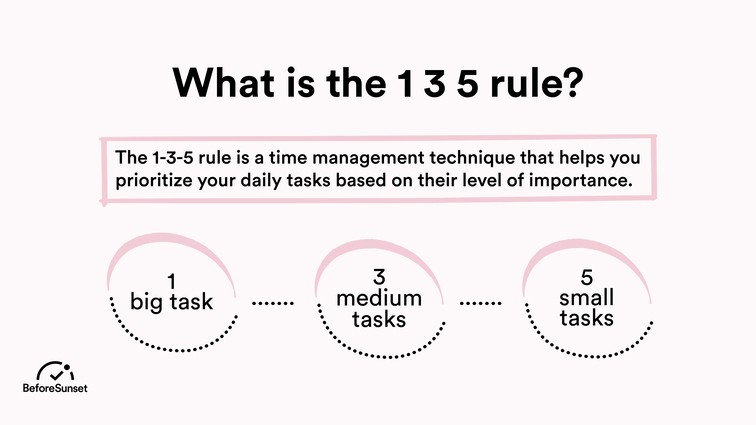
What is The 1 3 5 Rule?
The 1-3-5 rule is a time management strategy that aids in work prioritization and organization. Your to-do list will be divided into three groups according to the amount of time and effort needed to finish each task:
One major point: This is the most crucial duty you need to finish that day. It need to be the assignment that will have the most effect on your objectives maximum productivity or output.
Three medium-sized items: These are the subsequent most crucial jobs tomorrow's list that you must finish. These ought to be essential but not urgent duties.
Five minor points: You may finish these short and simple chores without any difficulty. These ought to be duties that, although nevertheless necessary, are not as crucial as those in the first two categories.
The 1-3-5 rule may assist you in focusing on your top priorities, avoiding feeling overburdened by your to-do list, and making sure that you get closer to your objectives each day.
The Difference Between Multitasking And The Ivy Lee Method
The Ivy Lee Method is a strategy that is shaped around the idea of finishing one task at a time while prioritizing the most crucial ones and doing them in that order. This method emphasizes that it is important to put your focus on only one task according to its order of importance. As the opposite of multitasking, it helps to reduce distractions and enhance focus.
On the other hand, multitasking is the act of doing several things at once. This strategy is based on the assumption that multitasking can boost productivity and that switching between projects can be done effectively.
As it can be challenging to retain concentration and keep track of numerous tasks, research has shown that multitasking can reduce productivity and raise stress. Eventually, multi-tasking leads to doing different tasks at the same time while consuming more than necessary, wasting valuable time and effort and ending up with unfinished tasks.
Can you Use The Ivy Lee Method with BeforeSunset?
Sure you can! With BeforeSunset's to do list using the Ivy Lee method is easier than ever.
It may be used to create a list of the daily tasks you have to complete and rate them in terms of importance. The application might help you organize your tasks and focus on the most crucial ones.
By keeping note of how much time you spend on each task, you might be able to better manage your time. This might help you stay on track and avoid wasting too much time on minor tasks.
Use BeforeSunset for mindful productivity!


